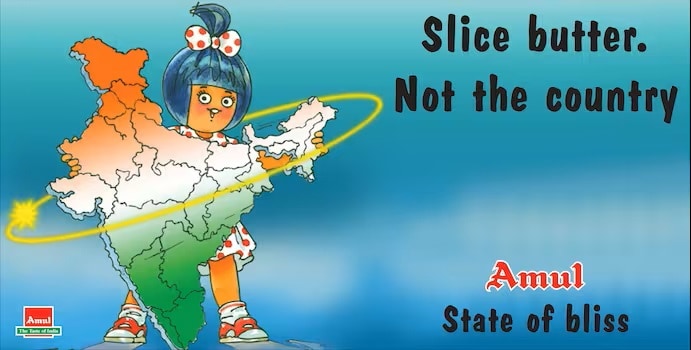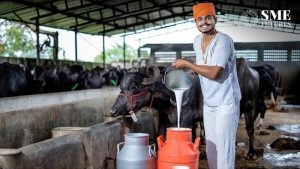
Nearly two decades after India’s independence, a little-known cooperative of small town dairy farmers in 1966 launched what became the most successful advertising campaign in the country’s history and helped transform India into the world’s largest producer of dairy and dairy products.
The economic business model developed by Amul, the dairy cooperative, spread throughout India as did its cartoon advertising mascot: a young girl with blue hair, a polka dot dress and an endless stream of witty one-liners commenting on the events of the day. The girl quickly became India’s most recognizable cartoon character, a cultural icon that spared no public figure.
More than 8,000 ads later, the Amul girl’s creator, Sylvester daCunha, died last month. But the era in which the girl could freely offer her tongue-cheek quips had already faded. Over recent years, she has had to tread carefully in a new India, within the shrinking space to poke — even in jest — at politics.

“From then to now is a story of how India has changed — in terms of tolerance, humor, in terms of regime, in terms of what we can do,” said Rahul daCunha, who took over his father’s advertising agency and the Amul butter portfolio in 1993. “My dad was courageous. He never stayed away from a topic. Today, I don’t have that luxury.”
Early Amul puns were indeed prickly, even daring. In 1976, when Prime Minister Indira Gandhi launched a campaign to sterilize the poor amid a wider crackdown on rights and freedoms, an Amul ad read: “We have always practised compulsory steralisation.”
After Amul ads offended various political parties, their members painted over its billboards in black. When airlines were offended, they threatened to stop using its butter. And when Amul offended the head of India’s cricket control board, he threatened to sue Amul’s chairman at the time, Verghese Kurien. Kurien wrote in response, “We are not here to massage the overblown egos of administrators,” according to Amul’s current managing director, Jayen Mehta.


In a 1996 article in Asian Age, reprinted on the Amul website, Rahul said, “We had the option of being sweet and playing it safe, or making an impact.” He said the billboards shouldn’t be “pleasant or tame. They have to say something.”
As Rahul was taking over from his father, India was seeing the rise of new politicians, a greater openness to the global economy and a transformation in Bollywood and pop culture. “By the mid-1990s, India had changed substantially. There were a whole host of topics that were not available to my dad,” Rahul recalled.
The times lent themselves to some of Amul’s best cartoons, with ads focusing on the United States’s war with Saddam Hussein’s Iraq (“Bushed? Solution is Sa Dam Easy), Bombay’s riots (“Don’t spread rumours, Do spread goodness”), a controversial Enron power project (“Enr On? Or off?), and Pakistan’s nuclear tests (“Panic istan!”).
The tone of the ads became “edgier” in the 1990s, with an “increasing comfort with sharper barbs,” said advertising professional Santosh Desai in a book by Rahul’s agency about the Amul butter brand.

Since then, the room for political satire has diminished.
“There has been a slight change in the last six or seven years in the sense that we’ve become a little bit more careful because of the kind of political winds that are blowing,” said Manish Jhaveri, who writes the ads. He added that Amul management has recently vetoed some ideas. “We used to be far bolder. Now we are afraid of boulders that might come our way.”
Rahul and Jhaveri both said they put a priority on using the Amul girl to market their product rather than ruffling feathers. “My business is selling butter,” said Rahul, his glasses perched on his forehead. “More or less stay within the subjects that make people smile. Stay away from topics that are a certain kind of politics.”
On religion, “completely back off,” he said, adding that the Amul girl still celebrates religious festivals, but anything more is an invitation for online trolling. During his father’s time, “religion was gentle. It wasn’t as extreme.”


Rahul said he has been shocked by the social media uproar to specific ads, including one referring to the government policy on the contested region of Kashmir and to a sexual assault case against a prominent magazine editor. Twitter banned Amul’s handle after an ad about boycotting Chinese products stated “Exit the Dragon.”
Brand strategist Sumeer Mathur said the Amul girl was never meant to be an activist. “The closest example is probably a late-night host, who’s playing within the rules of network television and what the audience wants,” Mathur said.
Amul’s products have also drawn political controversy. When it tried recently to enter the market in the southern state of Karnataka, Amul was met with protests. Amid hotly contested state elections, it was seen as linked to the central government of Prime Minister Narendra Modi, partly because Amul is based in his home state of Gujarat, said Koyna Tomar, a University of Pennsylvania Ph.D. student studying the growth of India’s dairy cooperatives.
Amul did not always carry such connotations. Early on, its dairy campaign linked milk and nutrition, spawning what was called the White Revolution and becoming a leading case study in India’s business schools. “They captured a moment when there was a lot of middle-class anxiety about being fit and healthy. Amul also created demand, not just captured demand,” said Tomar. India’s milk consumption quadrupled, as the act of children drinking a glass at the end of the school day became a household ritual.
While the Amul girl’s snark has tempered, she remains omnipresent. She’s on every packet of Amul milk, with 40 million sold per day. At least once a week, her ad is in the pages of the top 30 newspapers in the country, amounting to roughly 40 million copies, and her face appears on roughly a hundred billboards in the country, including one just three miles from the daCunha Agency’s Mumbai office — where illustrator Jayant Rane, 63, has sketched and painted every Amul ad by hand since 1988.
On a recent July afternoon, with incessant monsoon rains pounding outside, he scanned through his older works. On Israeli airstrikes in Gaza, one ad read “Tell Aviv to Stop.” On President Donald Trump’s sanctions against Tehran, “Can’t you Iran out the differences?” and on attempts to divide Indian states “Slice butter. Not the country.”
As he peeled apart pages from decades ago, he called the girl “baby” and explained that his digital efforts to draw her didn’t bring “the same effect.” He has stuck to the same brand of pencil and watercolors for 10 years.
“She’s an influencer before there were influencers,” Mathur said. “Every ad is a meme before that entire world even existed. She was doing it in an analog world.”

















